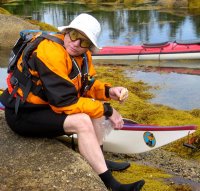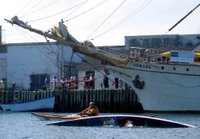Crossing over to the (Greenland) side

I'd been paddling for a few years with a Euro paddle, a Werner Camano, and had little interest in Greenland paddles. Most of the arguments in favor of one or the other I'd already heard, and I'd enjoyed the good-natured jousting that goes on between the adherents of each. But it seemed to me that the best arguments allowed neither a clear claim of superiority, and that plenty of good paddling could be done with either. Sure, I'd been unable to develop a roll with my paddle, but I was getting closer with each season, lesson, pool session. Soon I'd get it. My shoulders agonized after long paddles, but there was plenty of work to do to improve my technique and thereby avoid these self-inflicted injuries. Besides, whenever I'd tried a Greenland paddle, the blade seemed awkward and uncontrollable, diving and fluttering. Such sea trials never lasted more than a few minutes before I would insist on swapping back to my Werner.
It was on my first trip to Nova Scotia, in August of 2004, that I "crossed over to the dark side". I'm not sure why, for it was an unlikely and perhaps ill-advised place to do so. This would be my first venture into the swells of the open ocean, having kayaked mostly on the protected waters of rivers, large lakes and Long Island Sound. I'd not been in seas over 2-3 feet, and was more than a bit nervous about the first day's route (however benign it was in retrospect).
 As we prepared to launch, Andy and Fay were standing by their car, unloading cedar paddles from a roof top carrier made of capped pvc pipe. I made the mistake of admiring the paddles, which Andy had hewn from 4" X 4" western red cedar with a drawknife. (That's Fay and Andy at our lunch stop that first day). Still, I'm not sure what possessed me to leave my Werner strapped to my stern deck.
As we prepared to launch, Andy and Fay were standing by their car, unloading cedar paddles from a roof top carrier made of capped pvc pipe. I made the mistake of admiring the paddles, which Andy had hewn from 4" X 4" western red cedar with a drawknife. (That's Fay and Andy at our lunch stop that first day). Still, I'm not sure what possessed me to leave my Werner strapped to my stern deck. As the group glided through the harbor, Andy explained the dynamics of the Greenland stroke, pointing out differences from Euro technique. The catch requires less reach, with entry closer to the knees, and power application more gradual as the canted blade enters the water. The release is later, well behind the hips. As the fluttering of the blade diminished and my stroke became smoother, I began to move my kayak more efficiently. Before long I was appreciating the paddle's virtues.
As the group glided through the harbor, Andy explained the dynamics of the Greenland stroke, pointing out differences from Euro technique. The catch requires less reach, with entry closer to the knees, and power application more gradual as the canted blade enters the water. The release is later, well behind the hips. As the fluttering of the blade diminished and my stroke became smoother, I began to move my kayak more efficiently. Before long I was appreciating the paddle's virtues.It had always been difficult for me to initiate a turn with my 19'2" kayak... with little rocker, all that waterline length was designed to track straight. The extended greenland paddle allowed for a more powerful sweep stroke. That was my first revelation. Later, in choppier seas, I found the paddle gave me more support in a low brace, perhaps from its buoyancy, perhaps because the technique I was learning kept the weight of my arms and shoulders closer to my center of gravity. (I'm certainly no expert in this, and chances are I was over-extending in my sloppy Euro technique, something which may also account for my shoulder pain). In any event, with the greenland paddle I felt better balanced and pain free. Not to mention the smell of fresh cedar and the feel of wood in one's hands, added sensory pleasures for the paddling experience.
 The next day we launched from Canso. While lunching on a nearby island, we watched as the Europa sailed into the harbor. Andy and Sheldon (aka "TwoPaddles") practiced their greenland rolls when we returned, to the delight of assembled tourists.
The next day we launched from Canso. While lunching on a nearby island, we watched as the Europa sailed into the harbor. Andy and Sheldon (aka "TwoPaddles") practiced their greenland rolls when we returned, to the delight of assembled tourists.
I'd had many lessons with my Euro, but couldn't quite complete a roll. Sheldon offered to show me how using my new loaner, and promised he'd have me rolling with a greenland paddle before I headed home. (That's Sheldon paddling somewhere between the canal in Whitehead and the Sugar Islands).

After three half hour sessions, working braces, sweeps, and sculling, I completed my first roll (in Whitehead Harbor, NS, shown at left). I was hooked.

The only thing left to do was to make my own paddle, for this was the other great attraction of Greenland paddling. Cost-saving aside, there's something very special about things made with one's own hands. I'd had no woodworking experience before this project, and I looked at it as a trial run. My thoughts of building a wooden kayak were surely just pipe dreams if I couldn't create something as simple as a paddle. Before long, I was carving a 2' X 4' piece of western red cedar, following plans I'd found online on a site maintained by Chuck Holst. (One can download this as a pdf file at: http://www.qajaqusa.org/QK/makegreen2.pdf ). It took an afternoon, a pencil, a straight-edge, some clamps, a block plane, a jigsaw, some sand paper....et voila!
Building my own kayak was looking less and less like a pipe dream, and I was one step closer to my Outer Island.
